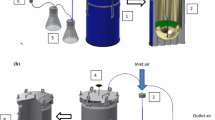Abstract
Distillery slop is the waste from alcohol manufacture, as from breweries or distilleries, which produce highly organic pollutants. This experiment studied bioextract that used distillery slop instead of molasses as a carbon source for the anaerobic digestion process. In this study, raw materials consisting of water spinach (Impomoea aquatica) residual, pineapple (Ananus comosus) residual, and fresh fish residual were used in the process to obtain the bioextract. The experiment was divided into three parts: a controlled experiment, mixed carbon sources (molasses and distillery slop), and a single carbon source (only distillery slop). The anaerobic digestibility of the bioextract was evaluated by a batch reactor at ambient temperature for a period of 90 days. The results of this study showed, by observing chemical oxygen demand (COD) at the initial and final processes, that the anaerobic digestive processes have a gradually decreasing rate throughout the fermentation period. The pH of the bioextract decreased at the beginning phase from pH 4 and increased to pH 7 in the last phase during the 90-day period. The results of a test with bean seeds showed compost maturity of over 80% following the organic fertilizer standard requirements of Thailand. With respect to variability, the optimal ratio generating the maximal compost maturity was 1:500 for the bioextract using only molasses as a carbon source and 1:250 for the bioextract using only distillery slop as a carbon source.
Similar content being viewed by others
References
Hati KM, Biswas AK, Bandyopadyay KK, Misra AK (2007) Soil properties and crop yields on a vertisol in India with application of distillery effluent. Soil Tillage Res 92:60–68
Vlissidis A, Zouboulis AI (1993) Thermophilic anaerobic digestion of alcohol distillery wastewaters. Bioresour Technol 43:131–140
Chaiprasert P (2002) Effect of bulking agent on molasses-composting from distillery. Pilot Plant Development and Training Institute, King Mongkut’s Institute of Technology, Thonburi, Thailand
Banerjee S, Biswas GK (2004) Studies on biomethanation of distillery wastes and its mathematical analysis. Chem Eng J 102:193–201
Khaliq A, Abbasi MK, Hussain T (2006) Effects of integrated use of organic and inorganic nutrient sources with effective microorganisms (EM) on seed cotton yield in Pakistan. BioresourTechnol 97:967–972
Production Research and Development Center (2004) Plant hormones and nutrients of bioextract. Department of Agriculture, Ministry of Agriculture, Thailand
International Seed Testing Association (ISTA) (1987) Handbook of vigour test methods. International Seed Testing Association, Zurich, Switzerland
Author information
Authors and Affiliations
Corresponding author
Rights and permissions
About this article
Cite this article
Srisatit, T., Chonchanachai, S. Bioextract production using distillery slop as a carbon source for the anaerobic digestion process. J Mater Cycles Waste Manag 13, 43–49 (2011). https://doi.org/10.1007/s10163-010-0301-1
Received:
Accepted:
Published:
Issue Date:
DOI: https://doi.org/10.1007/s10163-010-0301-1




